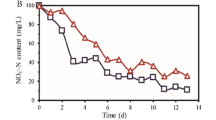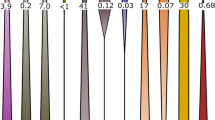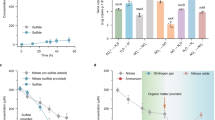Abstract
Sulfate-reducing bacteria have been extensively studied for their potential in heavy-metal bioremediation. However, the occurrence of elevated nitrate in contaminated environments has been shown to inhibit sulfate reduction activity. Although the inhibition has been suggested to result from the competition with nitrate-reducing bacteria, the possibility of direct inhibition of sulfate reducers by elevated nitrate needs to be explored. Using Desulfovibrio vulgaris as a model sulfate-reducing bacterium, functional genomics analysis reveals that osmotic stress contributed to growth inhibition by nitrate as shown by the upregulation of the glycine/betaine transporter genes and the relief of nitrate inhibition by osmoprotectants. The observation that significant growth inhibition was effected by 70 mM NaNO3 but not by 70 mM NaCl suggests the presence of inhibitory mechanisms in addition to osmotic stress. The differential expression of genes characteristic of nitrite stress responses, such as the hybrid cluster protein gene, under nitrate stress condition further indicates that nitrate stress response by D. vulgaris was linked to components of both osmotic and nitrite stress responses. The involvement of the oxidative stress response pathway, however, might be the result of a more general stress response. Given the low similarities between the response profiles to nitrate and other stresses, less-defined stress response pathways could also be important in nitrate stress, which might involve the shift in energy metabolism. The involvement of nitrite stress response upon exposure to nitrate may provide detoxification mechanisms for nitrite, which is inhibitory to sulfate-reducing bacteria, produced by microbial nitrate reduction as a metabolic intermediate and may enhance the survival of sulfate-reducing bacteria in environments with elevated nitrate level.
Similar content being viewed by others
Log in or create a free account to read this content
Gain free access to this article, as well as selected content from this journal and more on nature.com
or
Accession codes
References
Abdelouas A, Lu YM, Lutze W, Nuttall HE . (1998). Reduction of U(VI) by indigenous bacteria in contaminated ground water. J Contam Hydrol 35: 217–233.
Bagwell CE, Liu X, Wu L, Zhou J . (2006). Effects of legacy nuclear waste on the compositional diversity and distributions of sulfate-reducing bacteria in a terrestrial subsurface aquifer. FEMS Microbiol Ecol 55: 424–431.
Bender KS, Yen H-CB, Hemme CL, Yang Z, He Z, He Q et al. (2007). Analysis of a ferric uptake regulator (Fur) mutant of Desulfovibrio vulgaris Hildenborough. Appl Environ Microbiol 73: 5389–5400.
Borglin S, Joyner D, Jacobsen J, Mukhopadhyay A, Hazen TC . (2009). Overcoming the anaerobic hurdle in phenotypic microarrays: generation and visualization of growth curve data for Desulfovibrio vulgaris Hildenborough. J Microbiol Methods 76: 159–168.
Brooks SC . (2001). Waste Characteristics of the Former S-3 Ponds and Outline of Uranium Chemistry Relevant to NABIR Field Research Center studies ORNL/TM-2001/27. NABIR Field Research Center: Oak Ridge, TN.
Butler JE, He Q, Nevin KP, He Z, Zhou J, Lovley DR . (2007). Genomic and microarray analysis of aromatics degradation in Geobacter metallireducens and comparison to a Geobacter isolate from a contaminated field site. BMC Genomics 8: 180.
Cayley S, Record Jr MT . (2003). Roles of cytoplasmic osmolytes, water, and crowding in the response of Escherichia coli to osmotic stress: biophysical basis of osmoprotection by glycine betaine. Biochemistry 42: 12596–12609.
Chang Y-J, Peacock AD, Long PE, Stephen JR, McKinley JP, MacNaughton SJ et al. (2001). Diversity and characterization of sulfate-reducing bacteria in groundwater at a uranium mill tailings site. Appl Environ Microbiol 67: 3149–3160.
Chardin B, Dolla A, Chaspoul F, Fardeau ML, Gallice P, Bruschi M . (2002). Bioremediation of chromate: thermodynamic analysis of the effects of Cr(VI) on sulfate-reducing bacteria. Appl Environ Microbiol 60: 352–360.
Chase T, Rabinowitz JC . (1968). Role of pyruvate and S-adenosylmethionine in activating the pyruvate formate-lyase of Escherichia coli. J Bacteriol 96: 1065–1078.
Chhabra SR, He Q, Huang KH, Gaucher SP, Alm EJ, He Z et al. (2006). Global analysis of heat shock response in Desulfovibrio vulgaris Hildenborough. J Bacteriol 188: 1817–1828.
Clark ME, He Q, He Z, Huang KH, Alm EJ, Wan X-F et al. (2006). Temporal transcriptomic analysis as Desulfovibrio vulgaris Hildenborough transitions into stationary phase during electron donor depletion. Appl Environ Microbiol 72: 5578–5588.
Davidova I, Hicks MS, Fedorak PM, Suflita JM . (2001). The influence of nitrate on microbial processes in oil industry production waters. J Ind Microbiol Biotechnol 27: 80–86.
Fields MW, Bagwell CE, Carroll SL, Yan T, Liu X, Watson DB et al. (2006). Phylogenetic and functional biomakers as indicators of bacterial community responses to mixed-waste contamination. Environ Sci Technol 40: 2601–2607.
Finneran KT, Housewright ME, Lovley DR . (2002). Multiple influences of nitrate on uranium solubility during bioremediation of uranium-contaminated subsurface sediments. Environ Microbiol 4: 510–516.
Gillan DC, Danis B, Pernet P, Joly G, Dubois P . (2005). Structure of sediment-associated microbial communities along a heavy metal contaminated gradient in the marine environment. Appl Environ Microbiol 71: 679–690.
Greene EA, Hubert C, Nemati M, Jenneman GE, Voordouw G . (2003). Nitrite reductase activity of sulfate-reducing bacteria prevents their inhibition by nitrate-reducing, sulfide-oxidizing bacteria. Environ Microbiol 5: 607–617.
Gu B, Wu W-M, Ginder-Vogel MA, Yan H, Fields MW, Zhou J et al. (2005). Bioreduction of uranium in a contaminated soil column. Environ Sci Technol 39: 4841–4847.
Haveman SA, Greene EA, Stilwell CP, Voordouw JK, Voordouw G . (2004). Physiological and gene expression analysis of inhibition of Desulfovibrio vulgaris Hildenborough by nitrite. J Bacteriol 186: 7944–7950.
Haveman SA, Greene EA, Voordouw G . (2005). Gene expression analysis of the mechanism of inhibition of Desulfovibrio vulgaris Hildenborough by nitrate-reducing, sulfide-oxidizing bacteria. Environ Microbiol 7: 1461–1465.
Hazen TC, Stahl DA . (2006). Using the stress response to monitor process control: pathways to more effective bioremediation. Curr Opin Biotechnol 17: 285–290.
He Q, Huang KH, He Z, Alm EJ, Fields MW, Hazen TC et al. (2006). Energetic consequences of nitrite stress in Desulfovibrio vulgaris Hildenborough, inferred from global transcriptional analysis. Appl Environ Microbiol 72: 4370–4381.
Heidelberg JF, Seshadri R, Haveman SA, Hemme CL, Paulsen IT, Kolonay JF et al. (2004). The genome sequence of the anaerobic, sulfate-reducing bacterium Desulfovibrio vulgaris Hildenborough. Nat Biotechnol 22: 554–559.
Istok JD, Senko JM, Krumholz LR, Watson D, Bogle MA, Peacock A et al. (2004). In situ bioreduction of technetium and uranium in a nitrate-contaminated aquifer. Environ Sci Technol 38: 468–475.
Jain N, Thatte J, Braciale T, Ley K, O’Connell M, Lee JK . (2003). Local-pooled-error test for identifying differentially expressed genes with a small number of replicated microarrays. Bioinformatics 19: 1945–1951.
Jenneman GE, McInerney MJ, Knapp RM . (1986). Effect of nitrate on biogenic sulfide production. Appl Environ Microbiol 51: 1205–1211.
Joachimiak MP, Weissman JL, May BCH . (2006). JColorGrid: software for the visualization of biological measurements. BMC Bioinformatics 7: 225.
Jones HE, Trudinger PA, Chambers LA, Pyliotis NA . (1976). Metal accumulation by bacteria with particular reference to dissimilatory sulfate-reducing bacteria. Z Allg Microbiol 16: 425–435.
Knappe J, Schmitt T . (1976). A novel reaction of S-adenosyl-L-methionine correlated with the activation of pyruvate formate-lyase. Biochem Biophys Res Commun 71: 1110–1117.
Landa ER . (2005). Microbial biogeochemistry of uranium mill tailings. Adv Appl Microbiol 57: 113–130.
Liu H, Sadygov RG, Yates III JR . (2004). A model for random sampling and estimation of relative protein abundance in shotgun proteomics. Anal Chem 76: 4193–4201.
Lloyd JR, Renshaw JC . (2005). Bioremediation of radioactive waste: radionuclide–microbe interactions in laboratory and field-scale studies. Curr Opin Biotechnol 16: 254–260.
Lloyd JR, Ridley J, Khizniak T, Lyalikova NN, Macaskie LE . (1999). Reduction of technetium by Desulfovibrio desulfuricans: biocatalyst characterization and use in a flowthrough bioreactor. Appl Environ Microbiol 65: 2691–2696.
Lovley DR, Phillips EJP . (1992). Reduction of uranium by Desulfovibrio desulfuricans. Appl Environ Microbiol 58: 850–856.
Lovley DR, Roden EE, Phillips EJP, Woodward JC . (1993a). Enzymatic iron and uranium reduction by sulfate-reducing bacteria. Marine Geol 113: 41–53.
Lovley DR, Widman PK, Woodward JC, Phillips EJP . (1993b). Reduction of uranium by cytochrome c 3 of Desulfovibrio vulgaris. Appl Environ Microbiol 59: 3572–3576.
Moura I, Bursakov S, Costa C, Moura JJG . (1997). Nitrate and nitrite utilization in sulfate-reducing bacteria. Anaerobe 3: 279–290.
Mukhopadhyay A, He Z, Alm EJ, Arkin AP, Baidoo EE, Borglin SC et al. (2006). Salt stress in Desulfovibrio vulgaris Hildenborough: an integrated genomics approach. J Bacteriol 188: 4068–4078.
Mukhopadhyay A, Redding AM, Joachimiak MP, Arkin AP, Borglin SE, Dehal PS et al. (2007). Cell-wide responses to low-oxygen exposure in Desulfovibrio vulgatis Hildenborough. J Bacteriol 189: 5996–6010.
NABIR. (2003). Bioremediation of metals and radionuclides: what it is and how it works. In: Hazen TC, Benson SM, Metting FB, Faison B, Palmisano AC, McCullough J (eds). NABIR Primer. 2nd edn. Lawrence Berkeley National Laboratory: Berkeley, CA. pp 1–78.
Nyman JL, Marsh TL, Ginder-Vogel MA, Gentile M, Fendorf S, Criddle C . (2006). Heterogeneous response to biostimulation for U(VI) reduction in replicated sediment microcosms. Biodegradation 17: 303–316.
Payne RB, Gentry DA, Rapp-Giles BJ, Casalot L, Wall JD . (2002). Uranium reduction by Desulfovibrio desulfuricans strain G20 and a cytochrome c 3 mutant. Appl Environ Microbiol 68: 3129–3132.
Pereira PM, He Q, Valente FMA, Xavier AV, Zhou J, Pereira IAC et al. (2008). Energy metabolism in Desulfovibrio vulgaris Hildenborough: insights from transcriptome analysis. Antonie van Leeuwenhoek 93: 347–362.
Riley RG, Zachara JM . (1992). Chemical Contaminants on DOE Lands and Selection of Contaminant Mixtures for Subsurface Science Research DOE/ER-0547T. US Department of Energy: Washington, DC.
Rodionov DA, Dubchak I, Arkin AP, Alm E, Gelfand MS . (2004). Reconstruction of regulatory and metabolic pathways in metal-reducing δ-Proteobacteria. Genome Biol 5: R90.
Stolyar S, He Q, Joachimiak MP, He ZL, Yang ZK, Borglin SE et al. (2007). Response of Desulfovibrio vulgaris to alkaline stress. J Bacteriol 189: 8944–8952.
Valls M, de Lorenzo V . (2002). Exploiting the genetic and biochemical capacities of bacteria for the remediation of heavy metal pollution. FEMS Microbiol Rev 26: 327–338.
van den Berg WAM, Hagen WR, van Dongen WMAM . (2000). The hybrid-cluster protein (‘prismane protein’) from Escherichia coli: characterization of the hybrid-cluster protein, redox properties of the [2Fe-2S] and [4Fe-2S–2O] clusters and identification of an associated NADH oxidoreductase containing FAD and [2Fe-2S]. Eur J Biochem 267: 666–676.
Voordouw G, Grigoryan AA, Lambo A, Lin SP, Park HS, Jack TR et al. (2009). Sulfide remediation by pulsed injection of nitrate into a low temperature Canadian heavy oil reservoir. Environ Sci Technol 43: 9512–9518.
Wall JD, Krumholz LR . (2006). Uranium reduction. Annu Rev Microbiol 60: 149–166.
Wall JD, Yen H-CB, Drury EC . (2007). Evaluation of stress response in sulphate-reducing bacteria through genome analysis. In: Barton LL, Hamilton WA (eds). Sulphate-Reducing Bacteria: Environmental and Engineered Systems. Cambridge University Press: Cambridge, UK. pp 141–165.
Wang SC, Frey PA . (2007). S-adenosylmethionine as an oxidant: the radical SAM superfamily. Trends Biochem Sci 32: 101–110.
Wei J, Sun J, Yu W, Jones A, Oeller P, Keller M et al. (2005). Global proteome discovery using an online three-dimensional LC-MS/MS. J Proteome Res 4: 801–808.
Wolfe MT, Heo J, Garavelli JS, Ludden PW . (2002). Hydroxylamine reductase activity of the hybrid cluster protein from Escherichia coli. J Bacteriol 184: 5898–5902.
Wolters DA, Washburn MP, Yates III JRY . (2001). An automated multidimensional protein identification technology for shotgun proteomics. Anal Chem 73: 5683–5690.
Acknowledgements
This work was a part of the Environmental Stress Pathway Project (ESPP) of the Virtual Institute for Microbial Stress and Survival (http://vimss.lbl.gov) supported by the US Department of Energy, Office of Science, Office of Biological and Environmental Research, Genomics: GTL Program, through contract DE-AC02-05CH11231 with the Lawrence Berkeley National Laboratory.
Author information
Authors and Affiliations
Corresponding author
Additional information
Supplementary Information accompanies the paper on The ISME Journal website
Rights and permissions
About this article
Cite this article
He, Q., He, Z., Joyner, D. et al. Impact of elevated nitrate on sulfate-reducing bacteria: a comparative Study of Desulfovibrio vulgaris. ISME J 4, 1386–1397 (2010). https://doi.org/10.1038/ismej.2010.59
Received:
Revised:
Accepted:
Published:
Issue date:
DOI: https://doi.org/10.1038/ismej.2010.59
Keywords
This article is cited by
-
Long-term effective remediation of black-odorous water via regulating calcium nitrate sustained-release
Environmental Monitoring and Assessment (2023)
-
Valorization and Kinetic Modelling of Pediocin Production from Agro and Dairy Industrial Residues by Pediococcus pentosaceus CRA51
Waste and Biomass Valorization (2023)
-
Biohydrogen production potential with sulfate and nitrate removal by heat-pretreated enriched sulfate-reducing microorganisms-based bioelectrochemical system
Archives of Microbiology (2023)
-
Experimental evolution reveals nitrate tolerance mechanisms in Desulfovibrio vulgaris
The ISME Journal (2020)
-
Anion transport as a target of adaption to perchlorate in sulfate-reducing communities
The ISME Journal (2020)



